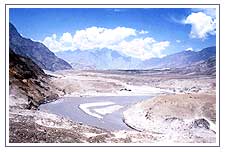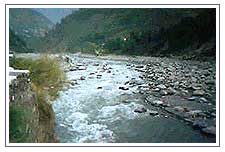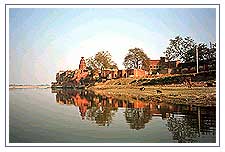
The
Himalaya, roof of the world, is a magic place where the magnificence of
the world's highest mountains is mirrored in the rugged beauty and
unique culture of the people who live in their shadow.
Duration: 06 Nights - 07 Days
Duration: 07 Nights - 08 Days
Duration: 08 Nights - 09 Days
Duration: 09 Nights - 10 Days
Duration: 11 Nights - 12 Days
Duration: 05 Nights - 06 Days
Home >> Rivers
in the Himalayas
Himalayas Rivers
| Major Himalayan Rivers: |
Indus, Sutlej, Ganga,
Yamuna, Brahmaputra |
Rippling along rough surfaces and the beautiful meadows, the numerous
rivers that dot Indian mainland are central to our history as well as to
Indian mythology. The main rivers of the Himalayas group are the Indus, the
legendary Ganga and the Brahmaputra. These rivers are both snow-fed and
rain-fed and therefore perennially flow throughout the year. Himalayan
rivers discharge about 70% of their inflow into the sea. This includes about
5% from central Indian rivers. They join the Ganga and drain into the Bay of
Bengal.
The very
names of these rivers roll like music-Jhelum, Chenab, Ravi, Beas and Sutlej.
Their ancient names were more musical still: "Vitasta", "Askini",
"Irawati", "Vipasha" and "Shatadru" ....

The Trans
Himalayan Indus River rises near the Mansarovar Lake on the Tibetan plateau.
It enters the Himalayas in southeastern Ladakh near its confluence with the
River Gurtang at an elevation of 4,200m. Thereafter it follows a north by
northwest course between the towering Ladakh range in the north and the
Zanskar Range in the south. There are a number of human settlements that lie
along the Indus River in Ladakh, namely Leh, Marol, Skardu and Bunji. ....
River Sutlej
takes birth on the southern slopes of the holiest of mountains - Kailash,
near the holiest of lakes Mansarovar. After a long run, parallel to the
Himalayas, it finally penetrates these at Shipki pass. Later it cuts through
the Zanskar range, makes a diagonal thrust through the Himalayas and blasts
a deep gorge at the base of the Kinner Kailash massif. Within Kinnaur
district, the Sutlej runs parallel to the Hindustan-Tibet Road. At Karcham,
in Kinnaur, it is joined by the crystal clear, blue river Baspa that drains
the Sangla valley .....
Chandra River
is one of the two rivers; the other one is Bhaga, which merges to form the
Chenab in the Lahaul region of Himachal Pradesh. It rises in the snows lying
at the base of the main Himalayan range in the Lahaul and Spiti district.
The picturesque lake of Chandra Tal forms at this rivers source site .....
The Beas
forms the valleys of Kullu and Kangra, famed for their beauty. But
ironically, its source is an insignificant looking igloo like structure near
Rohtang Pass in Pir Panjal range to the north of Kullu. The main thrust of
this river is southward to Larji and then to the west. Where it enters Mandi
district and further still into Kangra......

There is
something intrinsically romantic about the river Ravi. In divided Punjab
used to ring with the haunting strains of love songs sung on the banks of
the Ravi, which flowed past the elite city of Lahore. Now one only has to
hear the outpourings of young hearts in Chamba celebrating the beauty of
love and nature to know that the spirit of the Ravi is the same everywhere.
Chamba town rests on a mountain shelf on the right bank of the river. As a
settlement it is Indian to the core. Here, as in many ancient towns,
flourished a civilisation that provided patronage to the arts so that the
temple sculptures of Chamba are truly amazing.......
The Jhelum
flows from the spring known as Verinag, 80-km south of Srinagar. This wide,
swift flowing, muddy but picturesque river sweeps through Srinagar and is
famed for its nine old bridges among many things else ......
The valley of
Spiti derives its name from the Spiti River, which rises just below the
16,000 ft high Kunzum Pass. After flowing for about 60 miles, it joins the
Sutlej River near the village of Namgiya in Kinnaur district ......
The holiest
of all the rivers, Ganga or the Ganges is a perennial river, which is held
in high regard by the Hindus. The Ganga river has an exalted position in the
Hindu ethos. The Gangotri Glacier, a vast expanse of ice five miles by
fifteen, at the foothills of the Himalayas (14,000 ft) in north Uttar
Pradesh is the source of Bhagirathi, which joins with Alaknanda, to form
Ganga at the craggy, canyon-carved town of Devprayag.

Yamuna, also
called as "Jamuna", originates from the Bundar Poonch glaciers in
district Uttarkashi of the state of Uttaranchal. It rises from Jamunotri, in
the Himalayas. River Tons, which flows along the boundary of Himachal
Pradesh, west of district Tehri Garhwal joins Yamuna River at Kalsi and
thereafter joins the plains. From Kalsi, the river flows along the boundary
of Himachal Pradesh. Yamuna flows in a southerly direction through the
Himalayan foothills and onto the northern Indian plain, along the Uttar
Pradesh-Haryana State border. The Eastern and Western Yamuna canals are fed
from the river at that point.
One of the
great rivers of Asia, the Brahmaputra commences its 3,000-km journey to the
Bay of Bengal from the slopes of Kailash in western Tibet. As Tibet's great
river, the Tsangpo, transverses east across the high-altitude Tibetan
plateau north of the Great Himalayan Range, carving out myriad channels and
sandbanks on its way. As it tumbles from the Himalayan heights towards the
plains of the subcontinent it twists back on itself, cutting a deep and
still unnavigated gorge, until finally turning south it emerges in Arunachal
Pradesh as the Dihong. Just beyond Pasighat, it meets the Dibang and Lohit
where it finally becomes the Brahmaputra.




